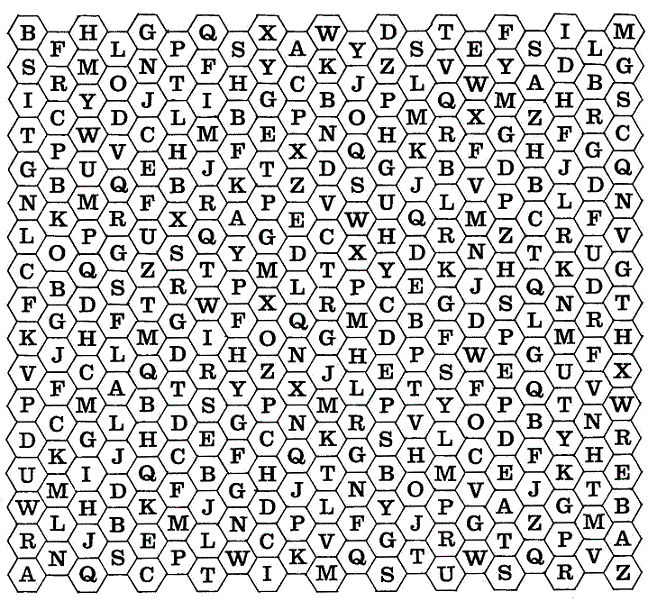
Here is a real challenger. The possible paths in this maze are never obvious, and they can cross over one another as in weave puzzles. The object is to start in any hexagonal cell along the left-hand edge and to move through adjacent cells until you reach the right-hand edge. There are three restrictions on any move:
- You must always move into a cell that shares a common wall with the cell you are leaving.
- You must always move into a cell containing a letter that is either a vowel (A, E, I, O, or U) or is later in the alphabet than the letter in the cell you are leaving.
- Never move into a cell whose letter rhymes with the letter in the cell you moved out of during your previous turn. For purposes of this puzzle, consider all the letters in each of the following groups to rhyme with other letters in its group – but not to rhyme with any other letters:
Group I – B, C, D, E, G, P, T, V, Z (American pronunciation)
Group II – A, J, K
Group III – Q, U, W
Group IV – I, Y
The above restrictions are tricky. Rule 2 requires you to relate your current location to your destination, tending toward vowels and the end of the alphabet. Rule 3 relates your previous location to your future location, remembering how you reached your current position. Solving this puzzle will involve your complete attention and perhaps several hours of your time. To avoid any misunderstanding of the rules, consider these examples:
- From the “B” in the upper left-hand corner you could move to either “F” or “S.” Both destinations are later in the alphabet than “B”, and the rhyming rule does not apply because “B” was the first cell occupied. If “C” or “D” occupied an adjacent cell, we would have moved there without worrying about the rhyme on the first move.
- If we had chosen to move to “S” in the last example, our next move must be to “I.” None of the cells adjacent to “S” are later in the alphabet, but “I” is a vowel. If a “T” or “W” were next to the “S”, the rhyming rule would allow us to enter “W” but not “T.” This is because “T” rhymes with “B” that we left on our previous move.
- Note that the rhyming rule will keep you from moving back into the cell you just left.
Jot down the letter in each cell that you pass through. Before you compare your answer with ours, double check your list of letters to be sure you have followed the rules every step of the way. Good luck, and be careful.
|

